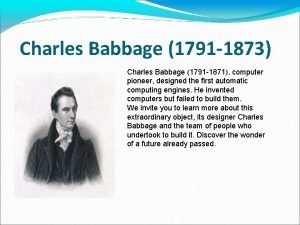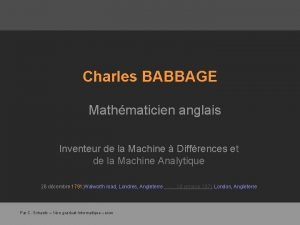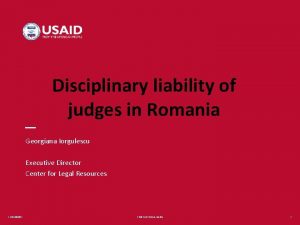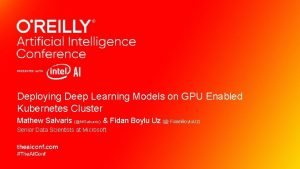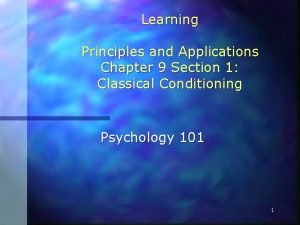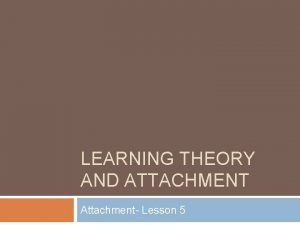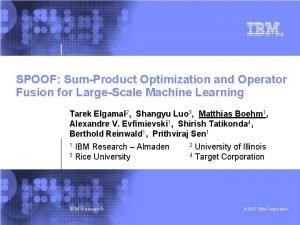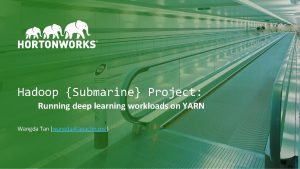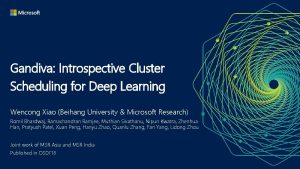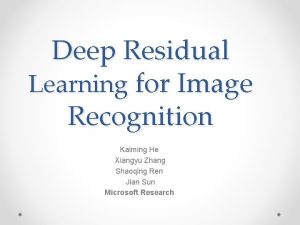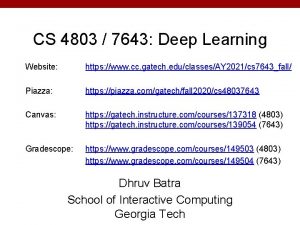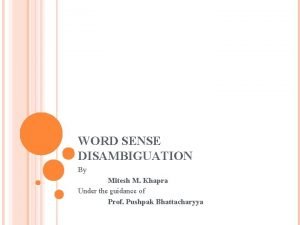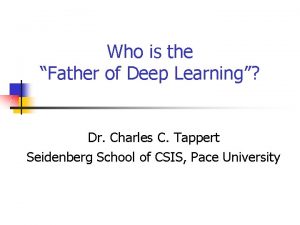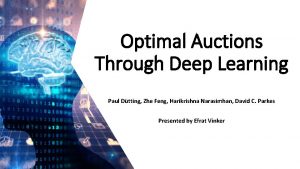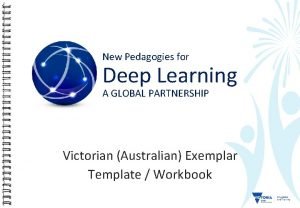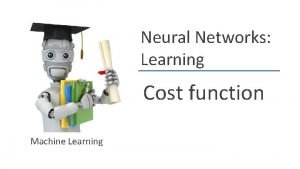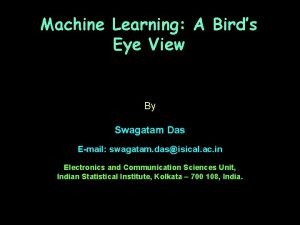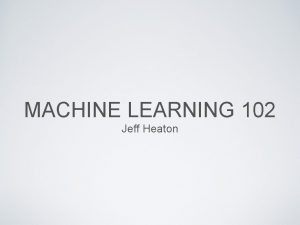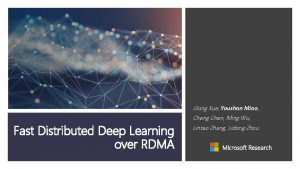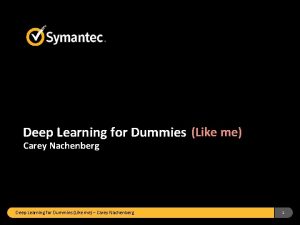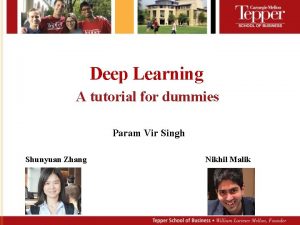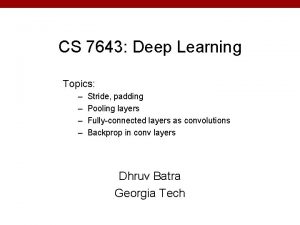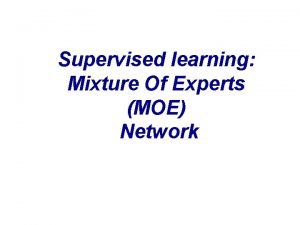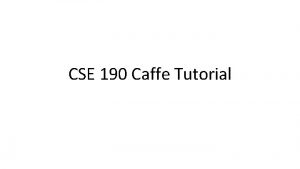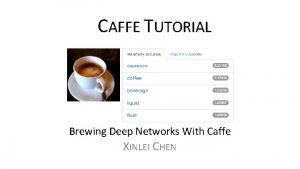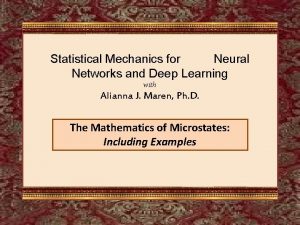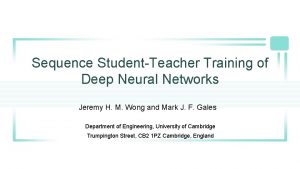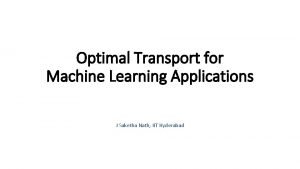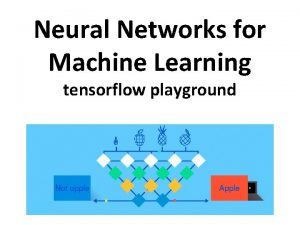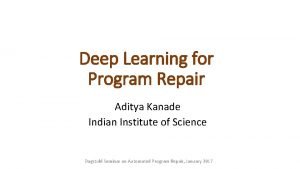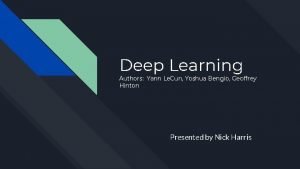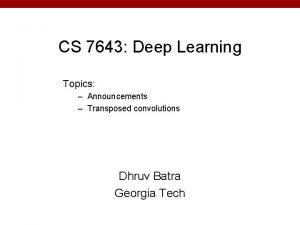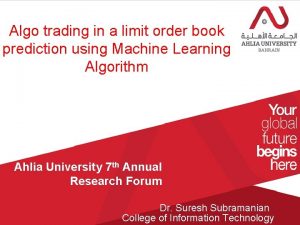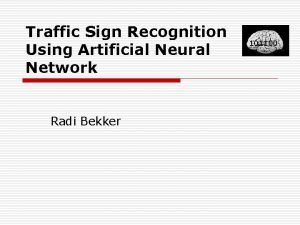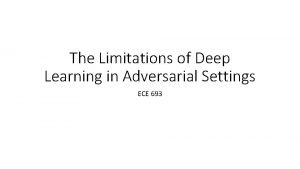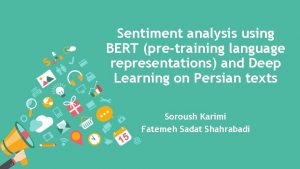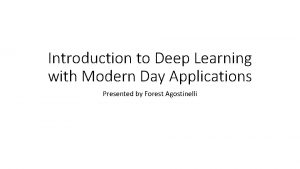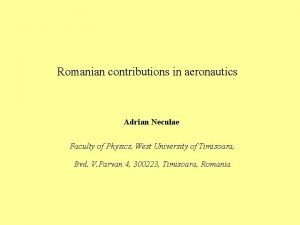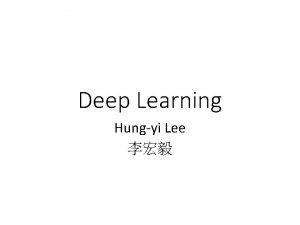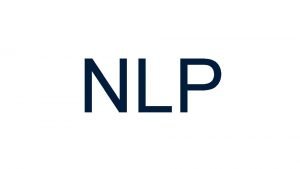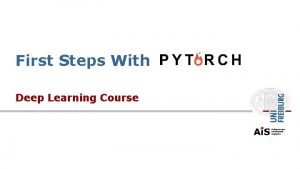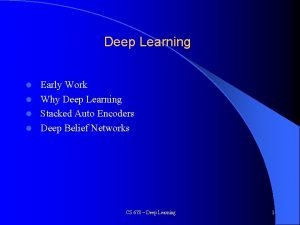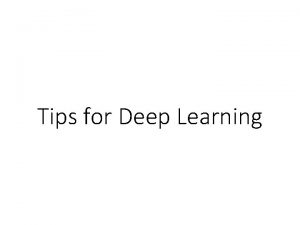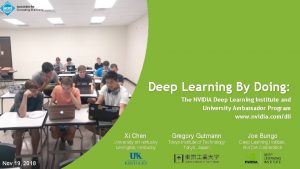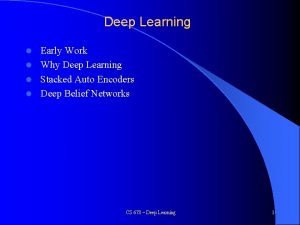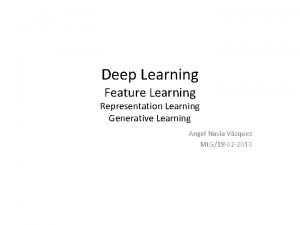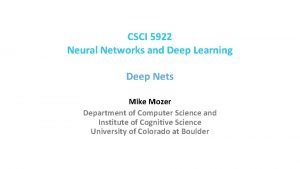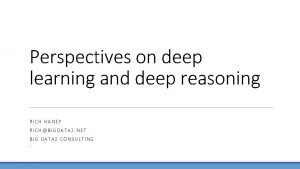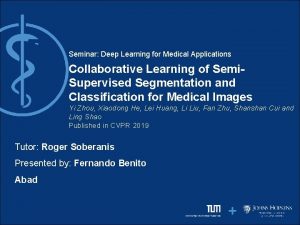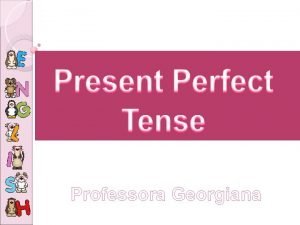Deep Learning Techniques and Applications Georgiana Neculae Outline
















![Perceptron ”the embryo of an electronic computer that [the Navy] expects will be able Perceptron ”the embryo of an electronic computer that [the Navy] expects will be able](https://slidetodoc.com/presentation_image_h/10cbd995fa606f48b61cd97757113a9b/image-17.jpg)
































- Slides: 49

Deep Learning Techniques and Applications Georgiana Neculae

Outline 1. Why Deep Learning? 2. Applications and specialized Neural Networks 3. Neural Networks basics and training 4. Potential issues 5. Preventing overfitting 6. Research directions

Why Deep Learning?

Why is it important? Impressive performance on what was perceived as exclusively human tasks: ● Playing games ● Artistic creativity ● Verbal communication ● Problem solving

Applications

Speech Recognition ● Aim: Input speech recordings and receive text. ● Why? (translation, AI assistants, automatic subtitles) ● Challenges come from the differences between pronunciations: ○ Intonation ○ Accent

Recurrent Neural Networks (RNNs) ● Make use of internal memory to predict the most likely future sequence based on what they have seen so far

Wave. Net ● Generates speech that sounds more natural than any existing techniques ● Also used to synthesize and generate music https: //deepmind. com/blog/wavenet-generative-modelraw-audio/

Object Detection and Recognition ● Why? (face detection for cameras, counting, visual search engine) ● What features are important when learning to understand an image?

Object Detection and Recognition ● Difficulty arises from: ○ Multiple objects can be identified in a photo ○ Objects can be occluded by environment ○ Object of interest could be too small ○ Same class examples could be

Convolutional Neural Networks (CNNs)

Object Recognition

Object Recognition http: //extrapolated-art. com/ https: //deepdreamgenerator. com/feed

Reinforcement Learning ● Learning is done through trial-and-error, based on rewards or punishments ● Agents independently develop successful strategies that lead to the greatest longterm rewards ● No hand engineered features or domain heuristics are provided, the agents being capable to learn directly from raw inputs

Reinforcement Learning Alpha. Go, a deep neural network trained using reinforcement learning, defeated Lee Sedol (the strongest Go player of the last decade) by 4 games to 1. https: //deepmind. com/blog/deep-reinforcement-learning/

Neural Networks Basics
![Perceptron the embryo of an electronic computer that the Navy expects will be able Perceptron ”the embryo of an electronic computer that [the Navy] expects will be able](https://slidetodoc.com/presentation_image_h/10cbd995fa606f48b61cd97757113a9b/image-17.jpg)
Perceptron ”the embryo of an electronic computer that [the Navy] expects will be able to walk, talk, see, write, reproduce itself and be conscious of its existence” Frank Rosenblatt, 1957

Perceptron to Logistic Regression (recap)

Logistic Regression (recap) ● Linear model capable of solving 2 class problems ● Uses the Sigmoid function to scale the output between [0, 1] f(x) w. Tx - t

Logistic Regression (recap) Uses the Log-loss function (cross entropy) to minimize the error:

Gradient Descent (recap) Update rule: Update parameters in the negative direction of the gradient. Negative gradient w 1 Increase value of Positive gradient w 1 Decrease value of

Gradient Descent (recap) Log-loss function: Gradient is given by the partial derivative with respect to parameter wi:

Gradient Descent Gradient is given by the partial derivative with respect to parameter wi:

Gradient Descent ● What if we add another unit (neuron) ● How do we update the parameters?

Gradient Descent Gradient is computed in the same way. How do we combine the outputs of the two neurons?

Multi-layer Perceptron ● Two neurons can only be combined by using another neuron:

Error Function ● Regression (network predicts real values): ● Classification (network predicts class probability estimates):

Gradient Descent Real value ● Note the use of the chain rule to compute the derivative

Back. Prop Real value ● How do we update w(0, 0) and w(0, 1) ? ● We propagate the error through the network.

Back. Prop Real value Descend to next layer and compute the gradient with respect to W(0, 0)

Deep Neural Network ● Can add more layers and neurons in each layer ● A bias neuron can be used to shift the decision boundary, as in the Perceptron:

Activation Functions ● Commonly used functions: f(x) x x

Activation Functions ● Sigmoid ○ Output can be interpreted as probabilities ● Re. Lu (Rectified Linear Unit) ○ No vanishing or exploding gradient ● Tanh (Hyperbolic Tangent) ○ Converges faster than the sigmoid function

Decision boundary ● XOR problem (non-linear) ● Neural Networks are nonlinear models Takasi J. Ozaki, Decision Boundaries for Deep Learning and other Machine Learning classifiers

Potential Issues

Local minima ● Caused by the high dimensional parameter space, which causes points to be saddle points instead ● Because of this, they are not an issue in practice

Vanishing gradient problem ● Appears when a change in a parameter’s value causes very small changes in the value of the network output ● Manifests in very small gradient values when the update of the parameter is computed

Vanishing gradient problem ● Appears in gradient based methods, caused by some activation functions (sigmoid or tanh) Output of function Input to function ● Magnified by the addition of hidden layers

Overfitting Bishop 2006: Pattern recognition and machine learning

Preventing Overfitting

Early Stopping

Weight sharing ● Parameters are shared by having the values stored in the same memory location ● Decrease amount of parameters at the cost of reducing model complexity ● Mostly used in convolutional and recurrent networks

Dropout ● Randomly omit some units of the network over a training batch (group of training examples) ● Encourage specialization of the generated network to the batch

Dropout ● It is a form of regularization ● Akin to using an ensemble, each trained on single batches

Conclusions

Summary ● Impressive performance on difficult tasks has made Deep Learning very popular ● Based on Perceptron and Logistic Regression ● Training is done using Gradient Descent and Backprop ● Error function, activation function and architecture are problem dependent

Research Directions ● Understanding more about how Neural Networks learn ● Applications to vision, speech and problem solving ● Improving computational performance, specialised hardware ○ Tensor Processing Units (TPUs) ● Moving towards more biologically inspired neurons

Libraries and Resources ● Tensorflow: great support and lots of resources ● Theano: one of the first deep learning libraries, no multi-GPU support (support discontinued) ● Keras: very high level library that work on top of Theano or Tensorflow ● Lasagne: similar to Keras, but only compatible with Theano ● Caffe: specialised more for computer vision than deep learning

Thank You!
 Charles babbage georgiana whitmore
Charles babbage georgiana whitmore Charles babbage georgiana whitmore
Charles babbage georgiana whitmore Georgiana iorgulescu
Georgiana iorgulescu Tony wagner's seven survival skills
Tony wagner's seven survival skills Deep learning vs machine learning
Deep learning vs machine learning Deep asleep deep asleep it lies
Deep asleep deep asleep it lies Deep forest towards an alternative to deep neural networks
Deep forest towards an alternative to deep neural networks 深哉深哉
深哉深哉 What is a quote sandwich
What is a quote sandwich Cuadro comparativo de e-learning
Cuadro comparativo de e-learning Autoencoders
Autoencoders Kubernetes vgpu
Kubernetes vgpu Learning principles and applications
Learning principles and applications Outline and evaluate the learning theory of attachment
Outline and evaluate the learning theory of attachment Operator fusion deep learning
Operator fusion deep learning Gated recurrent unit in deep learning
Gated recurrent unit in deep learning Hadoop deep learning
Hadoop deep learning Gandiva: introspective cluster scheduling for deep learning
Gandiva: introspective cluster scheduling for deep learning Deep residual learning for image recognition
Deep residual learning for image recognition Deep learning speech recognition
Deep learning speech recognition Cs 7643 deep learning
Cs 7643 deep learning Www.youtube.com
Www.youtube.com Sachin tendulkar
Sachin tendulkar Frank rosenblatt
Frank rosenblatt Regretnet
Regretnet Deep learning competencies 6 c's
Deep learning competencies 6 c's Cost function neural network
Cost function neural network Bird eye view deep learning
Bird eye view deep learning Jeff heaton deep learning
Jeff heaton deep learning Jilong xue
Jilong xue Carey nachenberg slides
Carey nachenberg slides Backpropagation for dummies
Backpropagation for dummies Pooling stride
Pooling stride Moe deep learning
Moe deep learning Xkcd
Xkcd Intel deep learning training tool
Intel deep learning training tool Caffe deep learning tutorial
Caffe deep learning tutorial Caffe deep learning tutorial
Caffe deep learning tutorial Statistical mechanics of deep learning
Statistical mechanics of deep learning Student teacher deep learning
Student teacher deep learning Optimal transport deep learning
Optimal transport deep learning Tensorflow playground
Tensorflow playground Aditya kanade
Aditya kanade Deep learning yoshua bengio authors
Deep learning yoshua bengio authors Cs7643
Cs7643 Deep learning for limit order books
Deep learning for limit order books Traffic sign recognition deep learning
Traffic sign recognition deep learning The limitations of deep learning in adversarial settings
The limitations of deep learning in adversarial settings Unsupervised sentiment analysis using bert
Unsupervised sentiment analysis using bert Deep learning
Deep learning
